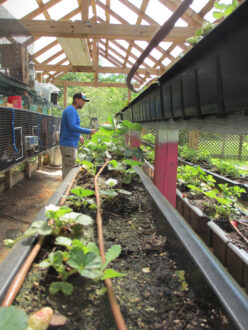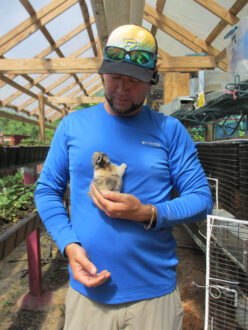KILN, Mississippi – The damage brought about by Hurricane Ida in 2021 was a light bulb moment for Mississippi farmer Stephen Wyatt, who was looking for ways to maximize production of his two high-demand cash crops: strawberries and rabbits.
With the storm came massive flooding, disease and predators. In less than one season, most of Wyatt’s strawberries succumbed to anthracnose and his rabbits (raised colony style) became targets for raccoons looking for food. In addition, Wyatt learned that raising chickens with rabbits does not mix: coccidiosis, its spread exacerbated by the flooding, nearly wiped out his rabbit herd.
Undaunted, Wyatt used his experience in mechanical engineering and his love for biology to explore an integrated greenhouse system designed to boost the welfare of the rabbits while improving the production of the strawberries. He received a Southern Sustainable Agriculture Research and Education (SSARE) Producer Grant to test his design.
“Having a coccidiosis outbreak, and a massive flooding record rainfall, as well as a continual attack by predators never before seen forced us to put a system in place that guarded against all of these inevitable, if not consistent deleterious effects on the system,” said Wyatt. “The rabbit and strawberry system that evolved from the original inception to the completed project is astoundingly optimized, and weather, pestilence and predator protection optimized.”
In the integrated system, Wyatt built 2’ X 4’ cages with vinyl-coated 1” X 5” wire to partition the animals for safety and to keep out predators, and placed them on 24” X 48” wall mount wire shelves along one side of an open air greenhouse. A watering and feeding system was installed for each housing unit. On the other side of the greenhouse, Wyatt built a vertical truss trellis system for the strawberry plants on 4’ X 4’ posts with 2’ X 4’ trough runners. Plants were placed in troughs for a hydroponic design. Shop fans were installed to increase overall air flow.

The idea behind the design was to create a seamless integrated system that optimized rabbit breeding while maximizing strawberry yields. The result was healthier rabbits and more productive strawberry plants.
“The benefit of cooling by strawberry plant shade and transpiration increases animal wellbeing and ultimate harvest weight and quality. The rabbit housing provides room to move which is not only excellent for meat quality, but also for physical and mental health,” said Wyatt. “The close proximity of the rabbits to the plants maximizes use of animal manure to make compost tea as a fertilizer for the strawberry plants. Lastly, the troughs better manage the crop’s feed and watering requirements and help manage diseases.”
The rabbits’ new housing was intrinsically placed within the strawberry plant rows for ease of management, for animal well-being and quality of life, said Wyatt.
“There is a strong case for larger cages for rabbit production. All of the rabbits that were more unmanageable before, became more docile and approachable in the new system,” he said. “The added transpiration from the plants aided in overall air quality. The other added benefit for having rows of rabbits next to rows of strawberries is the synergy of management. When working on the rabbits it is easy to cast a quick eye to the strawberries. Likewise when working the strawberries and removing any foliage or working on the water system, it gives time to enjoy the rabbits and check on their general health, not just viewing them in the normal feeding and cleaning schedule. The overall health of the rabbits and the extra care, focus and maintenance that came along with their proximity to the strawberries made this a very effective system.”
Wyatt also found that the application of the rabbit manure compost tea resulted in similar plant performance compared to using commercially available plant fertilizer. The plants more effectively set fruit, more successfully overcame disease and were generally a healthier crop compared to those in the field.
“The reduced cost of waste removal and the reduced cost of fertilizer usage work together to make both of these productions more economically viable as a farm operation,” he said. “By joining these two production systems a combined solution is generated that is cost saving, more sustainable and increases marketability of the product.”
